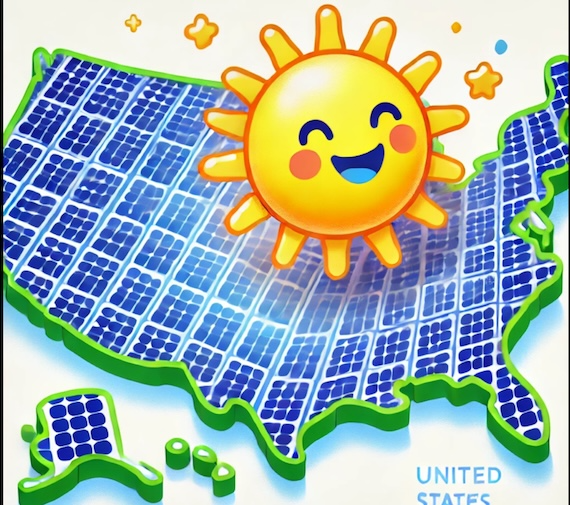Ann Arbor (Informed Comment) – The Business Council for Sustainable Energy Factbook is out, and it has good news for the environment despite the dark shadow being cast by a climate denialist White House.
The good news is that the incredible advance of solar power generation has boosted renewable sources of power to 24% of US power generation. When you combine that with U.S. nuclear power capacity, it means that our country is now at 42% zero- or very low-carbon sources of power for the first time since Thomas Edison established the coal-fired Pearl Street Station plant in New York in 1882.
Despite all the uncertainties in the market and despite high interest rates, America added 49 gigawatts of new solar to the grid last year, including rooftop generation. The US now has 220 gigawatts of solar, which means it installed 22% of all the solar power it has ever had in just one year, 2024. Installations last year substantially surpassed those in 2023, so we are on an upward curve.
There is a reason for all these solar advances. The levelized cost of solar this fall was 4.4 cents per kilowatt hour and it is 56% cheaper than the cheapest fossil fuels. The levelized cost of solar has fallen 90% since 2010.
It should nevertheless be pointed out that China has 886 gigawatts of installed solar capacity, nearly 4 times as much as we do, and that its solar installations skyrocketed by 46% last year. So we are still incredibly backward, and if Trump puts roadblocks in front of renewables, we will be left farther and farther in the dust by China. It matters, because someone is going to manufacture the equipment that electrifies every country on earth, and the Republican Party is ensuring that it won’t be us. Instead, we’ll be wallowing in dirty petroleum and coal, and destroying our childrens’ lives.
It wasn’t just solar that soared. Sustainables in general grew at the most rapid rate among all energy sources. Renewables are now the second-largest source of power generation in the U.S., providing 1,063 terawatt-hours (TWh). Only fossil gas generates more electricity, at 1,885 TWh. And its use increased in 2024, as well, just not at the same rate as wind, water, solar, geothermal and battery.

“Solar Nation,” Digital, ChatGPT, 2025
Wind, though, struggled in 2024. We only added about 7 gigawatts. I have a sinking feeling that it will struggle even more during the next four years, since Trump is so antagonistic to the industry and he just canceled new offshore wind leases managed by the federal government. Still, we’re hoping he’ll only be in office for 4 years, and there are lots of projects already in the pipeline that won’t even be finished before he is (fingers crossed) out of office.
Since the sun only shines during daytime, the best solar installations are combined with battery storage. American put in 11.9 gigawatts of battery energy storage last year, if we include utility-scale installations as well as distributed systems for homes and businesses. This surge of battery adoption was helped by a fall in battery prices and increased production. Supply and demand, folks. How much did battery pack prices fall last year? By twenty percent! They dropped to $115 per kilowatt-hour, a sharper reduction than at any time since 2017.
BCSE says that electric vehicle sales continued to grow, up 6.5% in 2024. Legacy automakers like Ford and GM saw their electric sales increase by double digits, while Tesla sales fell again. The electric car market is diversifying.
I have to wonder whether we will see a political switch, with conservatives buying Teslas where they buy electric at all, and liberals shifting to other models. Assuming Trump doesn’t find a way to discontinue the $7500 federal tax rebate on select EV models, the Chevy Equinox and Blazer look attractive, as does the Cadillac Optiq. And, remember that EVs save you money on gasoline. If you combine them with rooftop solar and charge during daylight, the fuel is free. So they are worthwhile even if you don’t get the tax rebate.
Anyway, the sustainable energy field is robust, and it is by now such a big part of the economy that mere presidential fiat cannot hope to derail this juggernaut. The market is far more powerful than the US government, and the market wants cheap energy, which is what wind, solar and battery provide.
The problem for humankind is that while the market can produce these big advances, like a 22% increase in solar installations in a single year, it just isn’t enough to get us down to zero carbon dioxide emissions by 2050. That is an astounding ask, and only a consortium of the world’s governments could hope to achieve it. That the US government will be not only useless but perhaps a negative factor for four whole years may end any hope of keeping global heating to an increase of 3.6 degrees F. over the pre-industrial norm.
Bruce Banner, the alternate ego of the Marvel superhero the Incredible Hulk, says “Don’t make me angry. You wouldn’t like me when I’m angry.” The earth is telling us, “Don’t make me hot. You wouldn’t like me when I’m hot.”
In the comics and movies, fools refuse to take Banner at his word. In the real world, we are blowing off the planet earth by driving gasoline cars and burning coal and gas to make electricity, and we and our descendants will come to regret it.
In the meantime, every half-degree of heating we can avoid is another set of catastrophes that do not happen.


 © 2025 All Rights Reserved
© 2025 All Rights Reserved